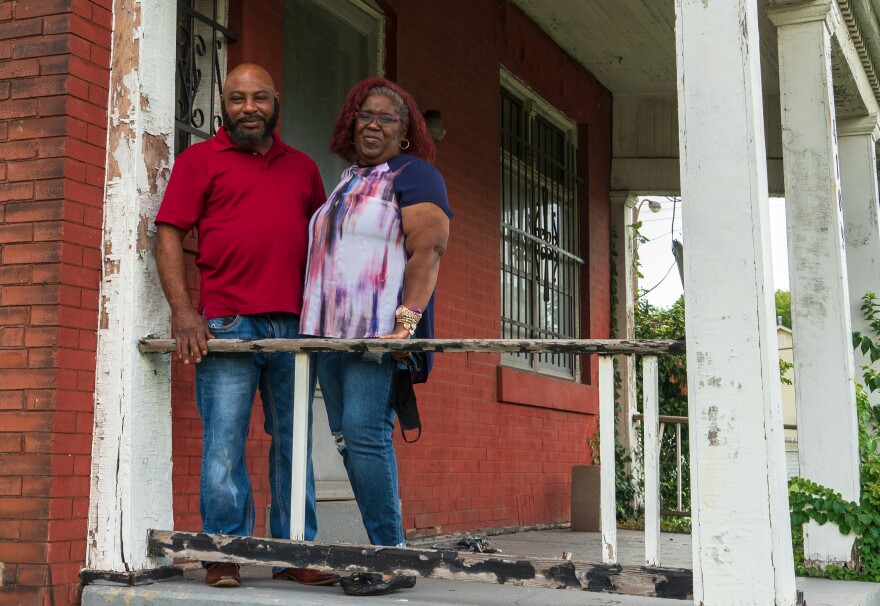Patricia Dees is losing patience.
Over the past two years, Dees and her partner, Damon Giboney, have gone to lender after lender, trying to get a loan to renovate a family home in north St. Louis.
Their applications have been denied — and the nearly 130-year-old home on Delmar Boulevard has sat vacant, slowly falling into disrepair.
“Nobody will give us a mortgage to fix up the property and help us build wealth, but they're willing to buy it from us for pennies,” said Dees, who estimates at least 10 investors have offered to buy the property.
St. Louis has the fourth-highest mortgage denial rate for Black people in the U.S., according to a recent analysis of federal data from LendingTree. Compared to the region’s overall mortgage denial rate, Black homebuyers in St. Louis are about three times more likely to have their loan applications rejected.
Denying loans based on location, known as redlining, is illegal. But housing advocates say current lending practices, in which approval hinges on credit scores and house appraisal values, unfairly disadvantage Black borrowers.
About 40% of Black families in St. Louis own a home compared to 77% of whites, the real estate brokerage company Redfin reported in June.
“We have a system that leans towards discrimination, even if nobody within it makes a consciously discriminatory decision,” said Glenn Burleigh, a community engagement specialist with the Metropolitan St. Louis Equal Housing and Opportunity Council.
Borrowers with good credit history and high annual income may still be unable to get a mortgage, especially if they’re looking to buy or refinance a home in a predominantly Black neighborhood.

Homes in historically redlined areas are often worth less than those in majority white neighborhoods, Burleigh added, which makes banks less likely to lend in these areas and creates a “capital blockade” around Black communities.
Few, if any, loans were awarded in north St. Louis neighborhoods in 2015 and 2016, according to publicly available data released through the Home Mortgage Disclosure Act and compiled by Reveal from the Center for Investigative Reporting.
But it’s not just homebuyers who are harmed by lending discrimination, Burleigh said. Without access to refinancing, homeowners may be unable to renovate or repair their properties.
“You're setting up a situation that makes it virtually impossible for people to keep up their property and do maintenance on it,” he said. “People turn around and say, ‘Oh, those folks don't know how to take care of their property.’ But the reality is the economy would never let them take care of their property with the same ease as it does in a majority white neighborhood.”
‘Come hell or high water’
Twice, Patricia Dees and Damon Giboney have come close to getting a $100,000 loan to renovate their home on Delmar.
In March 2018, Dees said, the couple met with a local lender to sign the final paperwork, only to discover that the company wanted more information about whether they planned to sell the home in the future.
Three months later, the same lender informed Giboney that his credit had dropped five points and the company would be unable to approve the loan.

“We were thinking that they're going to look at his background, his income, his credit score,” Dees said, noting that Giboney owns several rental properties in St. Louis. “But they took us through these hoops. At every turn, there was something.”
Dees, who recently became the president of the St. Louis Place Neighborhood Association, said her daughter and sister have also encountered challenges while applying for mortgages in the St. Louis area — and sometimes, it feels like the deck is stacked against them “because of the color of our skin.”
The family is now trying to scrape together enough money to fix up the three-story home, which needs a new roof, updated plumbing and electrical work. In the past six months, however, the City of St. Louis has fined them more than $500 for code violations on the property, including a missing porch railing and peeling paint.
“We take care of it, make sure the grass is cut and do our part,” she said. “Now, every time we turn around, they're sending us a letter. Even when the city was closed due to COVID, we received a letter from the code office.”
But Damon Giboney isn’t deterred.
As traffic rushed past on a recent afternoon, he stood on the sidewalk and eyed the house, from the overgrown bushes shading the porch to its cracked, fish-scale roof.
“Come hell or high water, I’m gonna get it done,” he said, smiling slightly.
Follow Shahla on Twitter: @shahlafarzan
Send questions and comments about this story to feedback@stlpublicradio.org


